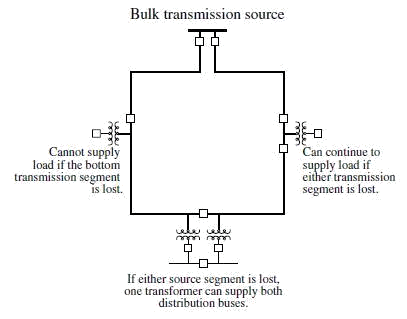Sub-transmission systems are those circuits that supply distribution
substations. Several different sub-transmission systems can supply
distribution substations. Common sub-transmission voltages include 34.5,
69, 115, and 138 kV. Higher voltage sub-transmission lines can carry more
power with less losses over greater distances.
Distribution
circuits are occasionally supplied by high-voltage transmission lines
such as 230 kV; such high voltages make for expensive high-side
equipment in a substation. Sub-transmission circuits are normally
supplied by bulk transmission lines at sub-transmission substations.
For
some utilities, one transmission system serves as both the sub-transmission function (feeding distribution substations) and the
transmission function (distributing power from bulk generators). There
is much crossover in functionality and voltage. One utility may have a
23-kV sub-transmission system supplying 4-kV distribution substations.
Another
utility right next door may have a 34.5-kV distribution system fed by a
138- kV sub-transmission system. And within utilities, one can find a
variety of different voltage combinations.
 |
| FIGURE 1.15 Radial sub-transmission systems |
Of
all of the sub-transmission circuit arrangements, a radial configuration
is the simplest and least expensive (see Figure 1.15). But radial
circuits provide the most unreliable supply; a fault on the sub-transmission circuit can force an interruption of several
distribution substations and service to many customers. A variety of
redundant sub-transmission circuits are available, including dual
circuits and looped or meshed circuits (see Figure 1.16).
The
design (and evolution) of sub-transmission configurations depends on how
the circuit developed, where the load is needed now and in the future,
what the distribution circuit voltages are, where bulk transmission is
available, where rights-of-way are available, and, of course, economic
factors.
Most sub-transmission circuits are overhead. Many are
built right along roads and streets just like distribution lines. Some —
especially higher voltage sub-transmission circuits — use a private
right-of-way such as bulk transmission lines use. Some new sub-transmission lines are put underground, as development of
solid-insulation cables has made costs more reasonable.
 |
FIGURE 1.16 Looped sub-transmission system
|
Lower
voltage sub-transmission lines (69, 34.5, and 23 kV) tend to be designed
and operated as are distribution lines, with radial or simple loop
arrangements, using wood-pole construction along roads, with reclosers and regulators, often without a shield wire, and with time-overcurrent protection.
Higher
voltage transmission lines (115, 138, and 230 kV) tend to be designed
and operated like bulk transmission lines, with loop or mesh
arrangements, tower configurations on a private right-of-way, a shield
wire or wires for lightning protection, and directional or pilot-wire
relaying from two ends. Generators may or may not interface at the
sub-transmission level (which can affect protection practices).
No comments:
Post a Comment